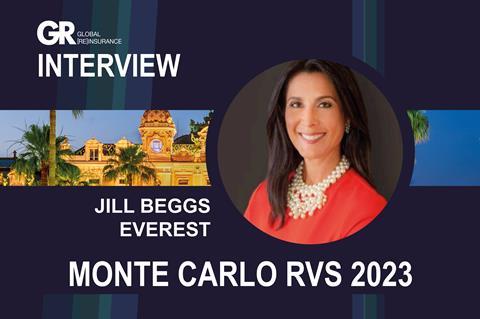Higher catastrophe losses are a new normal, and the market turn is an overdue pricing adjustment, argues Everest’s Jill Beggs.
The biggest near-miss of the 2023 hurricane season (thus far), Hurricane Idalia, which struck Florida at the end of August, was most notable as a continuation of the trend towards powerful storms that have battered the US, and the US property cat market, in recent years.

“Insured losses from those catastrophes have been rising for thirty years. It’s a continuation of what we’re already seeing,” Jill Beggs, head of North American reinsurance, Everest, told GR.
“From 2017, we have seen more than double the average losses coming through from the prior five years. Last year was the third-most expensive American hurricane season. And in the first half of this year, we’ve seen the costliest insured loss year ever.”
She went on: “And then we’ve also had the Hawaii wildfires, tropical storms in California, and wildfires in Canada.
Our big message is that property rates are justified and need to stay elevated in order to justify a healthy market. We saw a big market reset on 1 January, and we expect that to continue.
This year’s North American catastrophe events have been mid-size affairs, but serious retention events for local insurers, since the previous renewal raised the attachment points at which they bought reinsurance for their cat risk – leaving the brunt of losses with the primary market. Idalia, it turned out, would be another mid-sized storm loss, owing to the low population density area where it crossed the coast.
“We’re definitely seeing that, and there are examples,” said Beggs. “If you look at the earnings calls for the first half of the year, the cat loss ratios widened for some of the major carriers, especially in the US.
“That’s going to continue. I think the dynamics of any proportional deals could impact the sharing with reinsurers. I don’t think reinsurers will get away scot-free because they’re always paying losses,” she added.
Insurers will need to charge adequate rates for policies, rather than expect reinsurers to return to the previous pricing levels or relax their terms and conditions, she suggested.
This leads to the question of how the primary market will respond at the coming renewal, and whether there will be an exodus of insurers within Florida, or an adjustment on those providers to respond to cat events more ably.
“We’ve seen that happen,” said Beggs, “in places like Florida and California, where insurers have tried to achieve adequate rates, terms, and conditions, and pulling out of those states when they can’t get them.”
She went on: “I think a lot of the changes that have been implemented in Florida help. And I think that’s necessary because there was a breaking point for insurers and the lack of capacity for the policyholders in that state.”
Looking ahead, Beggs said that Everest was aiming to grow.
“We are doubling down, to grow with our core partners and cedents,” she said. “We raised $1.5bn of capital in the spring, with an equity raise that helps us support our clients and brokers at a time when it’s needed. We aim to continue do that through January renewal.”
There is strong momentum at play in favour of reinsurers.
“If you look at where we came from, our growth rate in 2021 was only 5%. The market was not where we felt it needed to be” Beggs said.
“It was lacklustre in the 2022 renewal season, so we pulled back capacity. But given that reset at the beginning of the year, we’ve seen nearly 20% growth in North American reinsurance. That’s similar across our global operation as well.










No comments yet